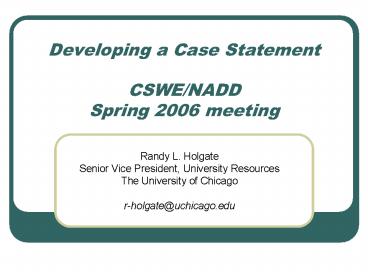Developing a Case Statement CSWENADD Spring 2006 meeting - PowerPoint PPT Presentation
1 / 26
Title:
Developing a Case Statement CSWENADD Spring 2006 meeting
Description:
'I find a universal belief in fairness, kindness, dignity, charity, integrity, ... Celebrate success. Recognize continued commitment. Increase engagement ... – PowerPoint PPT presentation
Number of Views:41
Avg rating:3.0/5.0
Title: Developing a Case Statement CSWENADD Spring 2006 meeting
1
Developing a Case StatementCSWE/NADDSpring
2006 meeting
- Randy L. Holgate
- Senior Vice President, University Resources
- The University of Chicago
- r-holgate_at_uchicago.edu
2
What we will cover
- Your development advantage
- Why make a case for support?
- Why a written case in only a beginning
- Characteristics of a solid program
- Donor focused fund raising
- Measures of success
- Challenges and Rewards
3
Skill base
- Communication
- Desire to help others
- Ability to build rapport
- Inclusiveness, others feel safe
- Optimism, belief in possibilities
- Meaning in your life, in what you do
- Teachers and learners
4
Belief in Positive Outcomes
- I find a universal belief in fairness, kindness,
dignity, charity, integrity, honesty, quality,
service and patience. - -Steven Covey
- Principal Centered Leadership
5
Mission Statement
- To seek and secure resources that will sustain
the University as a preeminent research and
teaching institution, by providing institutional
leadership in fund raising and alumni relations,
and by creating and nurturing a community of
alumni and other friends who help us achieve that
mission through their personal advocacy and
financial support. - The University of Chicago Office of
Development and Alumni Relations
6
Fund Raising Myth 1
- Its our job to convince people to give
- 240.72 billion of charitable giving in 2003
- 84 of college educated people make gifts
- 91 with post graduate study give
- Giving USA, 2004 researched at written at The
Center on Philanthropy at Indiana University
7
Fund Raising Myth 2
- Most gifts come from foundations and corporations
- Individual gifts comprise 75 of total giving
- 21.6 billion in bequests, 9 of total giving
- Giving USA, 2004 researched at written at The
Center on Philanthropy at Indiana University
8
Fund Raising Myth 3
- All we need are a few really big gifts
- 1 million donors begin with small gifts
- Gave first gift within 4 years of graduation
- Usually give multiple gifts each year
- CORE Group
9
Fund Raising Myth 4
- People give us what we ask for
- Giving is highly personal
- Match of interests and timing
- Yes and no can mean yes, no or maybe
10
Fund Raising Myth 5
- Giving is a rational decision
- Emotion, experience, and case influence donors
- Philanthropy is very personal
- Donor motivations vary
11
Characteristics of a solid development program
- Donor centric
- Focused
- Shared vision, goals, direction
- Clear priorities and plan
- Results oriented
- Integrated cross team
- Creative
- Responsive
- Consistent
- Forward looking
12
Giving inspires giving
- Gifts come from the heart
- The heart follows gifts
- Consistent donors give 50 more during their
lifetimes - Most 1 million donors began with small gifts
- Significant bequests come from consistent donors
of modest gifts
13
Philanthropic Relationships Lifecycle
Commitment
Engagement
Commitment
14
Commitment Gifts from Individuals
15
Prioritizing Activity
High move to solicitation Medium heavy
cultivation Low newer prospects
16
Critical Development Responsibility
- Clarify objectives
- Define pool
- Prioritize
- Strategize
- Communicate
- Track Progress
17
Quantitative Measures
- Contacts
- Visits, phone calls, letters, email
- Events, other initiatives
- Proposals
- Stewardship
- Dollars raised
- Participation rates
18
Qualitative Measures
- Regular discussion of what is happening in our
relationships - Assessment of quality, frequency, continuity
19
Self-Help for Effective Strategies
- Does your strategy deepen a prospects
relationship with your institution? - Does your strategy increase knowledge of your
prospects interests? - Does your strategy result in more information
about a prospects financial ability? - Does the strategy lead to a gift?
20
Food for Thought and Conversation
- What is the most satisfying gift you have ever
made to any institution? - How does it feel to be asked for a gift?
- What do you expect after you have made a gift?
- What has been most rewarding for you as a
volunteer? - What advice would you give to help us work better
with donors and volunteers?
21
Challenges
- Time
- Flexibility
- Achieving goals in timely way
- Resources
- Disappointments
- Discipline
22
Connect and recognize people
23
Build a culture of philanthropy
24
Celebrate success
25
Recognize continued commitment
26
Increase engagement































